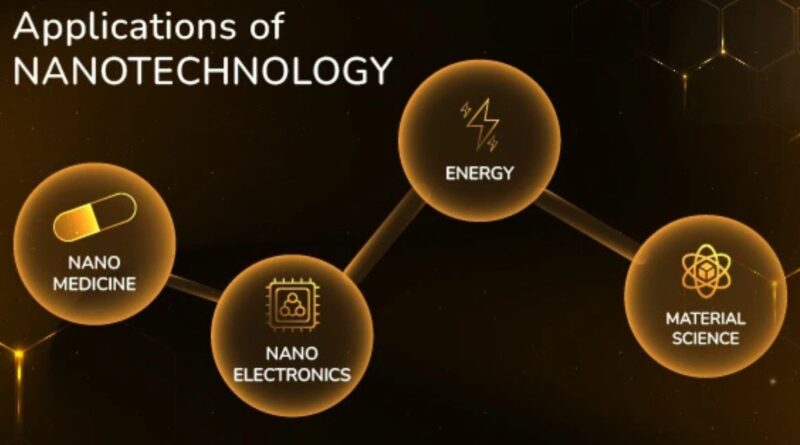Nanotechnology Applications: Transforming Industries and Shaping the Future
Nanotechnology is one of the most advanced fields of science, focusing on the manipulation of matter at the nanoscale, which is about one billionth of a meter. At this scale, materials display unique physical and chemical properties that differ from their larger forms. This field has emerged as a game changer, impacting various industries and creating possibilities that were once only imagined in science fiction. From medicine to electronics, energy, and agriculture, nanotechnology applications are rapidly transforming the way people live and work. In this article, we will explore nanotechnology in depth, highlight its major applications, and examine how it is driving innovation in multiple sectors.
Understanding Nanotechnology
Nanotechnology involves working with materials and devices at the nanometer level. Scientists and engineers can manipulate atoms and molecules to create structures with remarkable strength, electrical conductivity, chemical reactivity, and other unique properties. For example, nanoparticles often have a much larger surface area relative to their volume, which makes them highly reactive and suitable for specialized purposes.
This field combines principles of physics, chemistry, biology, and engineering, making it highly interdisciplinary. The ability to design and manipulate matter at such a small scale has unlocked opportunities that impact healthcare, manufacturing, environmental science, and even food production.
Applications of Nanotechnology in Medicine
One of the most promising areas of nanotechnology is medicine. The healthcare industry has embraced this field to improve diagnostics, drug delivery, and disease treatment.
Drug Delivery
Nanoparticles can carry medications directly to targeted cells, reducing harmful side effects and improving treatment outcomes. For example, chemotherapy drugs can be delivered more precisely to cancer cells without damaging healthy tissues. This targeted delivery allows for lower doses of medicine, reducing the strain on the patient’s body.
Medical Imaging
Nanotechnology has enhanced imaging tools used to detect diseases at earlier stages. Contrast agents made of nanoparticles improve the clarity of MRI and CT scans, helping doctors diagnose health conditions accurately.
Regenerative Medicine
Researchers are exploring nanomaterials to repair damaged tissues and organs. Nanoscaffolds support the growth of cells, making them essential in regenerative therapies for injuries, burns, or degenerative diseases.
Antimicrobial Treatments
Nanoparticles with antimicrobial properties can be used in bandages and medical equipment to reduce infections. Silver nanoparticles, for instance, are widely used for their ability to kill harmful bacteria and keep wounds clean.
Electronics and Computing
The electronics industry has been revolutionized by nanotechnology. As devices become smaller and faster, nanomaterials provide solutions to meet the growing demand for compact, high-performance technology.
Smaller and Faster Processors
Nanotechnology has enabled the development of transistors at an atomic scale, leading to smaller and more powerful processors. The integration of nanomaterials like carbon nanotubes and graphene in computer chips allows for faster data processing and reduced energy consumption.
Flexible and Wearable Electronics
Nanotechnology has led to innovations in flexible screens, wearable sensors, and electronic textiles. These devices can bend, stretch, and adapt to various shapes while maintaining functionality.
High-Density Storage
The creation of nanoscale storage devices has increased the capacity of hard drives and other storage media, making it easier to store large amounts of data in smaller spaces.
Energy Sector Innovations
The energy sector benefits greatly from nanotechnology, which improves energy generation, storage, and efficiency.
Solar Power
Nanomaterials like quantum dots and thin-film coatings increase the efficiency of solar panels, allowing them to absorb more sunlight and generate more energy. Nanotechnology also helps create lightweight solar panels, making renewable energy more accessible.
Batteries and Energy Storage
Nanotechnology improves the performance of batteries by increasing their capacity and reducing charging time. Lithium-ion batteries enhanced with nanomaterials have a longer life span and charge much faster than conventional options.
Fuel Cells and Hydrogen Storage
Nanomaterials help create efficient fuel cells and hydrogen storage systems. These systems could one day replace fossil fuels and provide cleaner energy solutions.
Energy Efficiency
Coatings made with nanomaterials can reduce heat loss in buildings and vehicles, contributing to energy savings. This application is valuable for reducing energy consumption and costs in residential and commercial buildings.
Environmental Applications
Nanotechnology offers innovative solutions to environmental challenges such as pollution, water scarcity, and waste management.
Water Purification
Nanomaterials like carbon nanotubes and nanofilters can remove impurities, bacteria, and viruses from water. These systems make clean drinking water more accessible, especially in areas facing water shortages.
Air Pollution Control
Nanoparticles can be used in air filters to capture harmful particles and gases. They can also be employed in catalytic converters to reduce vehicle emissions, contributing to cleaner air.
Soil Remediation
Nanotechnology helps clean contaminated soil by breaking down pollutants at the molecular level. This technique is essential for rehabilitating land affected by industrial waste or oil spills.
Waste Management
Nanotechnology offers solutions to recycle and reuse materials more effectively. By breaking down waste into its basic components, scientists can create valuable raw materials from discarded items.
Food and Agriculture
Nanotechnology is making farming and food production more efficient while ensuring food safety.
Precision Agriculture
Nanotechnology is used to create nanosensors that monitor soil health, moisture levels, and nutrient content. This information helps farmers apply fertilizers and water more effectively, reducing waste and increasing crop yields.
Pest Control
Nanopesticides are designed to target harmful insects without damaging beneficial organisms. This approach makes farming more environmentally friendly.
Food Packaging
Nanotechnology improves food packaging by making it more durable and capable of preserving food for longer periods. Nanomaterials in packaging can detect spoilage or contamination, helping reduce food waste.
Nutrient Delivery
Nanotechnology allows for the fortification of food with nutrients. Nanoparticles can deliver vitamins and minerals more efficiently, addressing malnutrition in some parts of the world.
Textiles and Consumer Goods
The textile and fashion industries have embraced nanotechnology to create fabrics with new properties.
Stain and Water Resistance
Nanocoatings applied to clothing make them resistant to water, stains, and wrinkles, reducing the need for frequent washing and ironing.
Smart Fabrics
Nanotechnology allows the creation of fabrics that can monitor body temperature, heart rate, and other health indicators. These innovations have applications in sportswear, healthcare, and military gear.
Lightweight and Durable Materials
Nanofibers and nanocomposites make fabrics stronger while keeping them lightweight. These materials are increasingly used in outdoor gear and protective clothing.
Aerospace and Automotive Industry
Nanotechnology is shaping the future of transportation, offering lightweight, strong, and fuel-efficient solutions.
Lightweight Materials
Nanocomposites used in aircraft and automobiles reduce weight, which leads to better fuel efficiency and performance.
Improved Safety
Nanomaterials are used in vehicle tires, brake systems, and protective gear to increase durability and safety.
Space Exploration
The aerospace industry relies on nanotechnology to create materials that can withstand extreme temperatures and radiation. Nanotechnology also plays a role in creating sensors for space exploration missions.
Military and Defense
Governments are investing heavily in nanotechnology for defense purposes.
Advanced Armor
Nanomaterials are used to create lightweight armor that provides superior protection to soldiers and vehicles.
Surveillance and Sensors
Nanotechnology has enabled the development of tiny drones and sensors that gather intelligence in dangerous environments.
Camouflage and Stealth
Nanocoatings help reduce radar visibility, improving stealth capabilities for military aircraft and ships.
The Future of Nanotechnology
Nanotechnology is still in its early stages, but its potential is limitless. Researchers are exploring ways to use nanotechnology in artificial intelligence, robotics, and advanced computing. As the field grows, it will reshape industries and introduce new opportunities for innovation.However, with great potential comes responsibility. The widespread use of nanomaterials raises concerns about environmental impact and human safety. Governments and researchers must establish regulations to ensure nanotechnology is used safely and ethically.
Conclusion
Nanotechnology has emerged as one of the most powerful scientific advancements of our time. It is revolutionizing industries, improving healthcare, making energy systems more efficient, and solving environmental challenges. From agriculture to space exploration, its applications are vast and transformative. As researchers continue to unlock new possibilities, nanotechnology will undoubtedly shape the future of humanity. By balancing innovation with responsibility, this incredible field can help build a safer, healthier, and more sustainable world.
FAQs About Nanotechnology Applications
What is nanotechnology?
Nanotechnology is the science of designing, manipulating, and using materials at the nanoscale, typically at the level of atoms and molecules.
How is nanotechnology used in medicine?
Nanotechnology is used in targeted drug delivery, medical imaging, regenerative therapies, and antimicrobial treatments to improve healthcare outcomes.
What role does nanotechnology play in electronics?
Nanotechnology makes processors smaller and faster, improves storage devices, and enables the creation of flexible, wearable electronic gadgets.
Can nanotechnology help the environment?
Yes. Nanotechnology purifies water, cleans polluted soil, reduces harmful emissions, and helps manage waste through advanced recycling techniques.
How does nanotechnology improve agriculture?
Nanotechnology enables precision farming through nanosensors, enhances food packaging, and delivers targeted pesticides to protect crops more efficiently.
What are the risks of nanotechnology?
Nanotechnology raises concerns about toxicity, environmental effects, and ethical use, making regulation and safe practices critical for its future.
Which industries use nanotechnology the most?
Major industries include medicine, electronics, energy, agriculture, aerospace, defense, textiles, and environmental science.
Is nanotechnology expensive?
Currently, some nanotechnology applications are costly due to research and production challenges, but costs are expected to decrease over time.




